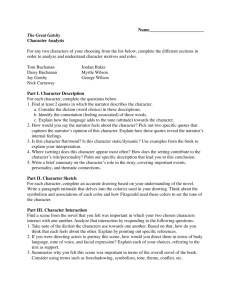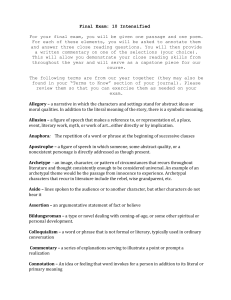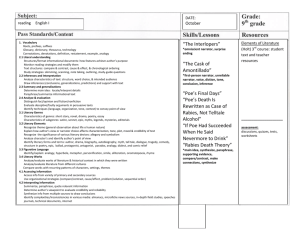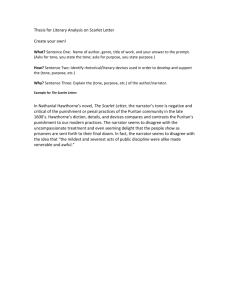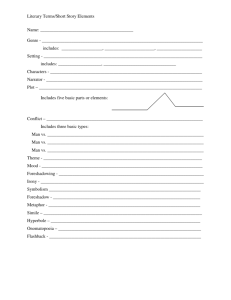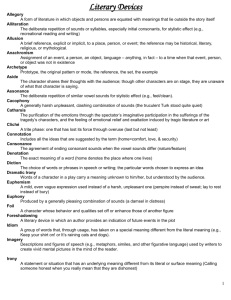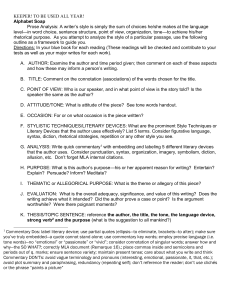the c for connotation
advertisement
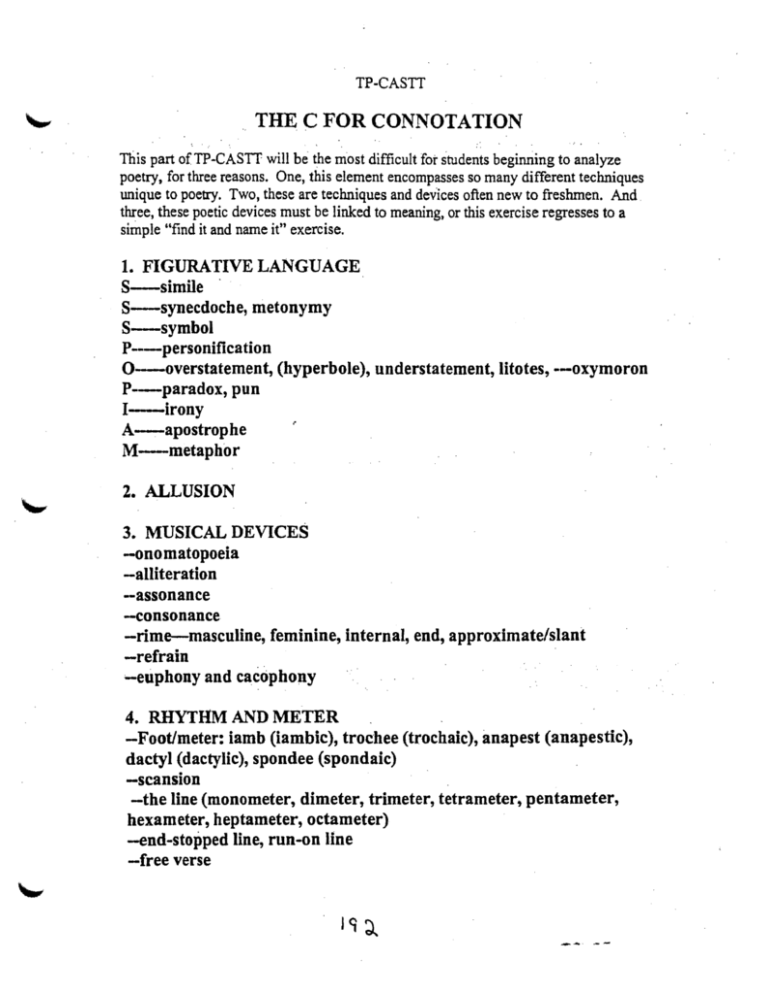
TP-CASTT
'. THE C FOR CONNOTATION
This part ofTP-CASTT will be the most difficult fot students beginning to analyze
poetry, for three reasons. One, this element encompasses so many different techniques
unique to poetry. Two, these are techniques and devkes often new to freshmen. And.
three, these poetic devices must be linked to meaning, or this exercise regresses to a
simple "find it and name it" exercise.
1. FIGURATIVE LANGUAGE
S-simile .
S-synecdocbe, metonymy
S-symbol
P---personification
O-overstatement, (hyperbole), understatement, litotes, --oxymoron
P---paradox,pun
I-irony
A-apostrophe
M-metaphor
2. ALLUSION
3. MUSICAL DEVICES
-onomatopoeia
-alliteration
-assonance
-consonance
-rime-masculine, feminine, internal, end, approximate/slant
-refrain
--euphony and cacophony
4. RHYTHM AND METER -Foot/meter: iamb (iambic), trochee (trochaic), anapest (anapestic), dactyl (dactylic), spondee (spondaic) -scansion -the line (monometer, dimeter, trimeter, tetrameter, pentameter, hexameter, heptameter, octameter) -end-stopped line, run-on line -free verse _
....... ~--
--blank verse
5. IMAGERY
6. PATTERNS
--stanzas.
-sonnet (Italian and English)
--villanelle
-haiku
--epic
.-heroic couplet
-tercet
-terza rima
--quatrain
POEM POET .,..?OETRY WHEEL E
M
lqt ..
TP-CASTT
THE C FOR CONNOTATION
This part ofTP-CASTT will be the most difficult fot students beginning to analyze
poetry, for three reasons. One, this element encompasses so many different techniques
unique to poetry. Two, these are techniques and devices often new to freshmen. And
three, these poetic devices must be linked to meaning, or this exercise regresses to a
simple "find it and name it" exercise.
1. FIGURATIVE LANGUAGE
S-simile
S-synecdocbe, metonymy
S-symbol
P---personification
O-overstatement, (hyperbole), understatement, litotes, -oxymoron
P--paradox, pun
I-irony
A-apostrophe
M--metaphor
2. ALLUSION
3. MUSICAL DEVICES -onomatopoeia --alliteration --assonance -consonance -rime--masculine, feminine, internal, end, approximate/slant -refrain --euphony and cacophony 4. RHYTHM AND METER -Foot/meter: iamb (iambic), trochee (trochaic), anapest (anapestic), dactyl (dactylic), spondee (spondaic) wwscansion w-the line (monometer, dimeter, trimeter, tetrameter, pentameter, hexameter, heptameter, octameter) -end-stopped line, run-on line -free verse -- --
-blank verse
5. IMAGERY
6. PATTERNS
-stanzas.
-sonnet (Italian and English)
--villanelle
--haiku
--epic
-heroic couplet
-tercet
-terza rima
--quatrain
_ -­
....
sEN-SORT IMPRESSIONS
.
.'
:
.
.
RELATING TO THE OBJECT WHICBYOtT HAVE
OBSERVED,. ·.LIST.· 'J'HREE OR .MORE.
IMPRESSIONS· ·ON YOUR SE~SES IN EACH
AREA:
VISUAL (SEEING)
AUDITORY (HEA1UNG)
~.
GUSTATORY (TASTE) ..
TACTII,E (TOUCH)
KINESTHETIC (MUSCULAR REACTION) OLFACTORY· (SMELL)
~
:'
~
J.'1 6,
.
Response Journal Guidelines for Students
• Take time to write down anything in relation to the text. If you're
intrigued by certain statements or if you're attracted to characters or
issues or problems, write your response. Try to take at least five minutes
to write when you've finished an assignment or when you've put your
book down for a break. You may want to write something that strikes
you then.
• Make connections with your own experience. What does the reading
make you think of? Does it remind you of anything or anyone?
• Make connections with other texts or concepts or events. Do you see any
similarities between this text (concepts, events) and other texts
(concepts, events)? Does it bring to mind other related issues?
• Ask yourself questions about the text: What perplexes you about a
particular passage? Try beginning, "I wonder why... " or "I'm having
trouble understanding how.. .' or "It perplexes me that. .." or "I was
. d w hen .... "
surprIse
• Try agreeing with the writer. Write down the supporting ideas. Try
arguing with the writer. On what points, or about what issues, do you
disagree? Think of your journal as a place to carry on a dialogue with the
writer or with the text in which you actually speak with him or her. Ask
questions; have the writer respond. What happens when you imagine
yourself in hislher shoes?
• Write down striking words, images, phrases, or details. Speculate about
them. Why did the author choose them? What do they add to the story?
Why did you notice them? Divide your notebook page in half and copy
words from the text onto the left side; write your responses on the right.
On a first reading you might put checks in the margin where the
passages intrigue you; on the second reading, choose the most interesting
ideas, then write about them.
• Describe the author's point of view. How does the author's attitude shape
the way the writer presents the material?
These guidelines were developed in collaboration with Anne Herrington and the faculty of the Bard College lAnguage and Thinking Program.
Today you're going to learn five different literary techniques. These are different devices
people use when writing, especially when writing poetry. You actually use these in every
day speech but you just didn't know their names.
Hyperbole - an exaggerated idea or statement. For example, That basketball player
must have been over ,Iellfeet tall.
Alliteration - a sentence where the first letter of two or more words have the same
consonant sound. For example, The dumb dog sat on the dirty door mat.
Onomatopoeia - where the sound of the word suggests its meaning. For example, slam,
buzz, screech, crush, sizzle.
Simile - a direct comparison between two things using the word "like," (A simile will
always use the word "like.") For example. Life is like a box ofchocolates... or 'The car
roared like thunder.
Metaphor - like a simile, a metaphor compares one thing to another. However, it
doesn't just say one thing is like another, it says one thing is another. For example,
During Christmas. my hOllse is a circlis. Or, His apartment was a pig sty.
Why do you think we use these literary devices when we speak or write? Do they make
things mor~ interesting? Do the similes and metaphors make what you're saying easier to
understand because you're using examples.
Instructions:
You and a partner will be given several sheets of paper with a few lines from a song or
poem. You will also have five slips of paper listing the five different literary devices we
discussed. Make five piles with the sheet~ of paper according to which literary device is
illustrated in the song or poem.
We will discuss your choices afterwards.
function does symbolism seem to serve in the novel? Use direct quotations from the text to support your
observations.
FIGURATIVE LANGUAGE: Language is not literaL Metaphorical devices link meaning: most common
devices include: METAPHOR, SIMILE, PERSONIFICATION AND ALLUSION. Point out examples
(direct quotes) and discuss how they are used and how often.
IRONIC DEVICES: Irony adds extra dimensions to meaning and sets up special understanding between
reader and writer. The most common include VERBAL, SITUATIONAL, OR DRAMATIC IRONY,
PARADOX, OXYMORON, EUPHEMISM, HYPERBOLE, or UNDERSTATEMENT. Point out
examples and discuss how they are used and how often.
TONE: Author's attitude toward subject, characters and reader. Could be playful, serious, angry, ironic,
formal, somber, satiric, etc. Generally an author uses a limited variety oftones, often two or three
complementary ones. Discuss the book's tone and observe how the author creates it through plot, diction,
syntax, imagery, and figurative devices. Use direct quotations from text to support observations.
THEME: The theme refers to the book's controlling idea or central insight. IdentifY the book's central
theme. IdentifY any prominent secondary themes. Express as statement and predicate, not as a word or
phrase (Le. Wrong: "loyalty" or "loyalty to country"; Right: Loyalty to country often inspires heroic self­
sacrifice") Discuss any motifs you can identifY. (Motifs: dominant ideas in a work of literature, a part of a
major there. It may consist of a character, a recurrent image or a verbal pattern.) Discuss author's intention.
SIGNIFICANCE OF THE TITLE: What message does the author want to convey with the title? Does
the meaning of the title change for the reader from pre to post reading?
MEMORABLE QUOTES: Choose five to eight quotes from the novel that capture the essence of plot,
character or style. Discuss their significance to the work.
RESEARCHfLITERARY CRITICISM: Read at least two critiques or literary reviews. Be sure these
come from substantial, reputable sources such as a New York Times review or academic sources and not
Cliffs Notes or Sparknotes or just some guy n the Internet who thinks he knows what he is talking about.
Read and digest the information and write a short summary of what you gained from the reading. Please
note that you are summarizing your reaction to the article not the article itself.
ADDITIONAL COMMENTS: Did you enjoy the novel? Strength, weaknesses, lingering questions? Does
it relate to other books you have read? Any insights into human folly or triumph
BIBLIOGRAPHY: Attach a bibliography of any outside sources you use.
Moliere, Sartre, Racine, Horner, Pope, Dostoevsky, Ellison, Euripides, Aeschylus,
Tolstoy, Swift, Voltaire, Rousseau, St. Augustine, Cervantes, Chaucer, Marlow,
Lawrence, T. S. Eliot, George Eliot, Camus, Hardy, Auden, Fitzgerald, Hemingway,
Hesiod, Sophocles, Baldwin, Marquez, Faulkner, Dante, Sappho, Plato, Aristotle, Virgil,
Ovid, Seneca, Wordsworth, Shakespeare, Donne, Pindar, Aristophanes, Goethe, Blake,
Coleridge, Austen, Kant, Stoker, Emerson, Bryant, James, Byron, Yeats, Mann, Twain,
Johnson, Milton, Dickens, C. Bronte, E. Bronte, Locke, Hobbs, Mill, Malory, Woolf,
Kafka, Keats, Shelley, Pushkin, Browning, Whitman, Melville, Dickinson, Poe, Conrad,
Joyce, the "J" writer, author(s) of The Epic ofGilgamesh, Beowulf, The Bhagavad Gila,
The Ramayan, The Egyptian Book ofthe Dead
Things to remember:
1. Literary Analysis is 1) Assertion, 2) Evidence, and 3) Commentary
2. It's All About the Tone
3. Voice is different than Tone
Look for:
1. Setting
2. POV: A) first: active, passive, non-participant, relation to characters; B) third:
omniscient, limited, limited to whom?
3. Voice: What type of voice?
4. Tone and shifts in Tone
5. Allusions: literary, historical, biblical, popular culture
6. Type of Writing (fiction/nonfiction, genre, satirical, philosophical, etc)
7. Diction (slang, etc.)
8. Syntax (sentence structure)
9. Rhetorical devices (Figurative Language)
10. Imagery
11. Writer's intent
12. Author/time period connection
13. Evidence: repetition, context clues, detail
Rhetorical devices:
Figurative Language: antithesis, apostrophe, hyperbole, metaphor, metonymy,
oxymoron, personification, simile, symbolism, synecdoche, understatement
Other: foreshadowing, irony, juxtaposition, paradox, repetition, parallel structure
Review ofprevious literary terms
Narrator: the voice that is telling the story. The telling of the story can be from a few different
perspectives (or points of view).
Point of View
1. First person point-of-view: the
is in the story and says "I," "me," and "we."
2. Second person point-of-view: reader is a part of the story; "you were walking to the store and
you stepped on a frog"; rarely used in English.
3. point-of-view: the narrator is not in the story; always says "he,"
"she," "they," etc. Can be limited (knows the thoughts of one or a few characters) or omniscient
(knows the thoughts of all characters)
Tone
o Tone is the attitude the narrator takes toward the subject matter of the story_ Tone is, in a sense, the
_._ _.
the narrator takes to the work. The narrator does not always equal the author
(narrator i= author). Example:
, a female, writes The Secret History from the
perspective of Richard Papin, a male.
o We can determine the tone through
and how the words are put together
(sentence structure).
a house. The narrator says, "The
Example: Let's say the narrator of a story is
house was that dismal shade of gray reserved only for tombstones and gloomy days. It was beaten
down and worn out. It could fall in on itself at any moment." We know the tone is somewhat
negative. The narrator doesn't like the house. What if, however, the narrator describes it this way:
"The house was big and old and
. It could have been the very house where
Cathy and Heathcliff grew up together." In this case, the narrator speaks about it in a positive way.
The narrator
the house.
o There are four main categories oftone (but there are many variations within each):
~_ _ _ _ _:
idealized view of the work; seeing the world with your heart and not your head; (not
the everyday use of the word); extreme sincerity, idealized outlooks, virtues/vices, heroes/villains,
excessive optimism
satiric/ironic: a sense of disillusionment, distrust of all appearances, a mocking or cynical outlook;
verbal irony is often used (verbal irony is saying the opposite of what you mean)
tragic/dramatic: straightforwardness, profound awareness - - - - - - - , a sense of loss of
perfection or goodness, awareness of sin and evil, a fall from greatness
comedic: moderated optimism,
belief in perfectibility, hope for _________
(we know life is not perfect, and the pessimism that comes about turns to black comedy)
* Example of each with getting your driver's license
There are always tone shifts within a work of literature. Even in a short work, there is often at least one.
*Example from driver's license scenario.
Title Genre
--------------~~--------~------Author_________ ~_
# Pages_ _ Copyright Date_ __
THE AUTHOR AND HIS OR HER TIMES: BornlDied: biographical information important to the
understanding of the novel; important community, national and world events that influenced the author and
the novel; other artistic or literary influences; critical responses and literary standing during lifetime and
posthumously.
FORM, STURCTURE. AND PLOT: How is the novel organized? Length? Chapters? Discuss such
techniques as flashbacks or dream sequences, stream of consciousness, chronological order of events,
foreshadowing, parallel events, multiple, complex or simple plot. How much time is covered? Compare and
contrast beginning and ending.
POINT OF VIEW (NARRATIVE PERSPECTIVE): Is the novel written in first ("I), second ("yoU") or
third ('he/she") person point of view? Is it written in present or past tense? If in the first person, is he/she
the protagonist or an observer? If in third person, is he/she omniscient (knowing everything), limited
omniscient (knowing one character most often), or objective (no subjective commentary by the narrator)?
Are there any shifts in point of view during the novel? (Shifts might come from the changed view(s) of the
narrator or from different narrators) What effect does the author achieve with the point of view and what
seems to be hislher purpose?
CHARACTER: General comments: Flat/round? Static/dynamic? Believable? How are they revealed?
How complex? How many? Protagonist/antagonist? Role of minor characters? Describe 4-6 central
characters: name, age, three descriptive adjectives, appearance, personality, function in the novel, a key
quote that reveals the character with an explanation of what that quote reveals.
SETTING: Where and when does the novel occur? How is the environment described? Any symbolic
meanings in the settings? How does the author use the setting? What attnosphere/mood is created by the
setting? How important is setting to the novel?
DICTION: Analyze the author's word choices. First discuss the work in general: is the language formal,
informal, vernacular ... ? Explain and give an example from the text. Does the author use much imagery?
Metaphoric and / or ironic devices? Is the language plain? Flowery? Concise? Strong? Lyrical? Does
diction indicate social status, education, region? How much dialogue is used? How different is the dialogue
from the narrative voice? How distinct is the dialogue from character to character? Select three passages
(minimum approximately one-half page) featuring three different plot segments. Copy the segments and
include in your report. Close (close!) read the passages, then discuss the diction. Comment on how diction
helps define character, set tone, further theme, etc.
SYNTAX: (Word order, pattern) Analysis of sentence and phrase patterns.
1. Make some general observations: Are the sentences predominately simple or complex.
What about length? Level offormality? Any fragments? Rhetorical questions? Parallel
structure? Repetitions? Are sentences loose, periodic? Is there much variety to the
sentence pattern? How does the author use syntax to create rhythm and flow of the
language? How does the author use syntax to enhance effect and support meaning?
2. Using one ofthe same passages from the diction section above, focus on the author's
syntax. What effect is he/she creating? Comment on how these choices help define
character, set tone, further theme, etc.
CONCRETE DET AILIIMAGERY: Words or phrases that appeal to the five senses most commonly
visual. Look for recurrent images. What function does the imagery seem to have? Use direct quotations
from text to support observations.
SYMBOLISM: When an image is used to suggest another meaning it becomes a symbol (Le., dove for
peace, red for passion). Is the novel highly symbolic? Allegorical? Point out images used as symbols. What
Tragedy
Tragedy. What does the word call to mind for you? How can it best be defined? Before we defer to Aristotle for his definition
(especially with its literary implications), let's consider what it means to us as we use it in our own lives. Tragedy, in its most
general sense, means a human devastation--sudden, unforeseen and usually immense. It's a devastation that can occur at many
levels-the personal, the familial, the societaL A personal tragedy could be perhaps the moment you learn the love of your life
doesn't love you in return. Such was the case with poor Wherther in Goethe's The Sorrows o/Young Wherther. At the familial
level, we experience tragedy when we learn a family member has passed away. In Romeo and Juliet, each other's love was
requited, yet their love was not to be since their farnilies were in a blood feud. The knowledge of their joint suicides was a
tragedy on the grand scale for each family. An example of social, or national, tragedy would be of course the loss of lives on
September II at the World Trade Towers. It is a gaping, common loss Americans feel any time we see images of the wreckage at
ground zero, knowing what mass of humanity would be exhumed from the debris.
It is because we experience tragedy in our everyday lives that we find it in literature. We find it earliest, and perhaps at its finest,
in the classical tradition. Aeschylus first rendered tragedy in drama, but Sophocles refined it. And nowhere will we find a better
example of it than in Sophocles' Oedipus Rex. I know what you're thinking. If it's old, it can't be that good. It won't seem
impressive to your young minds since the landscape of Ancient Greece is unfamiliar to you. In short, the story will have nothing
to do with you. But it is the best, and most succinct, and it is the example we will use.
Returning to the World Trade Towers, there's a striking tragic irony we feel when we now see images of the towers standing
stalwart like twin giants guarding Manhattan. It is a tragic irony of situation because we know their fate. And when we see
images ofthose towers with black plumes ofsmoke billowing skyward from their flanks, we feel a keen sense of tragic irony
because we know the fate of those poor souls still trapped inside: they will come tumbling down with the bUildings.
Now we are ready to invite Aristotle into our conversation. In his Poetics, Aristotle lays out the guidelines for how a tragic play
should be written. We won't go over all of his criteria, but we will study the essentials. His criteria were used in the Festival of
Dionysus in his day, and are used to some extent, if at least unconsciously, in our valuation of tragedies we see in film and read in
literature in our own day.
Here are the terms from Aristotle we will need to know.
Fate-~
_______~_______________~___________________________________~_______~_____
Tragic Hero - ________._ _____________________________________~_____
Tragic Flaw (hamartia) - ________________________________
Complication - ___________________________________________
Recognition and reversal of situation - ________________________________
Deaus ex machine -
Catharsis ­
_~
_____________________~_____________
----------
in medias res
10. Descriptive Writing
a. Worksheet over "sensory details"
11. Parts of Speech handout
12. Journal 2 Topic handout
13. Greek Prefixes, Suffixes, Root words handout
14. "Orpheus and Eurydice," "Echo and Narcissus," and "Theseus and the Minotaur"
handout
a. also, fill out the events on the plot structure for each story
15. Write your own Greek myth handout
16. First Draft of Descriptive Writing Paper
17. Phrases Packet handout
18. Quiz over:
1. "In Any Story" elements; you will apply them to a story you haven't read.
2.20 Vocabulary Words
3. imagery and personification
4. Content of the three myths from Assignment #9
19. Test over information from quiz
20. For your own AR book, fill out the sheet provided concerning setting, mood,
character, and tone. handout
21. Tonal Words exercise handout
22. Vocabulary handout (on same paper as #23)
23. Symbols, foreshadowing, voice handout (on same paper as #22)
24. Personification handout
tragedy
resolution??
transitions
progression of ideas
correct word choice
homonyms
subject/verb agreement
run-on sentences
combining sentences
main point
details/supporting details
KWL
mood
flashback
allusion
irony
dialogue
text structure/pattern
chronological order
compare and contrast
cause and effect problem-and-solution making inferences (explicit ideas/implicit ideas) drawing conclusions making predictions (character reactions, details of plot, setting, and character, foreshadowing) identifying author purpose source credibility modes of persuasion (overgeneralization, circular reasoning, faulty cause and effect) pathos ( individual experience, universal experience loaded language bandwagon appeal testimonials English II
Assignments
1. Brewster the Rooster
a. "In Any Story"
2. "The Story Teller" p. 41 (Adventures in Appreciation)
a. "In Any Story"
b. Reading Check 1-5;
c. For Study and Discussion 1-3
3. Journal Topic: "Write ajournal about the best summer you've ever had"
a. write one-page journal, paying attention to focus and elaboration
b. look at someone else's paper and tell them what to improve upon
4. TAKS Preparation Workbook
a. pages 1 - 6
5. Writing Assignment
Receive packet for Descriptive Essay (30 minutes)
a. read explanation about dominant impression and sensory details
b. read "The Diner at Midnight"
i. underline dominant impression throughout text
ii. circle sensory details
6. Vocabulary
rarity, unsympathetic, suppressed, munnur, ferocity, primitive, hesitatingly,
galvanized, pious, inscrutable
a. Give definition, b. part of speech, c. make a sentence of your own
7. "Tuesday Siesta" p. 223
a. "In Any Story"
b. Reading Check p. 228 1 - 5
c. For Study and Discussion 1 - 2
8. T AKS Preparation Workbook
a. pages 7 - 12
(imagery and personification)
9. From purple Myths and Legends book, read "Mother Earth and Her Children," "Zeus
and the Creation of Mankind," and "Persephone"
a. questions handout
b. list 3 instances of personification; how did it add to the story?
c. list 3 instance of imagery; how did it add to the story?
d. What is the main idea ofeach story?
